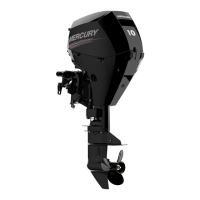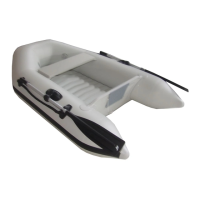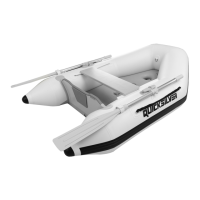CAUTION
Never start or operate your outboard (even momentarily) without water circulating through all the cooling water
intake holes in the gearcase to prevent damage to the water pump (running dry) or overheating of the engine.
FUEL SYSTEM
IMPORTANT: Gasoline containing alcohol (ethanol or methanol) can cause a formation of acid during storage and
can damage the fuel system. If the gasoline being used contains alcohol, it is advisable to drain as much of the
remaining gasoline as possible from the fuel tank, remote fuel line, and engine fuel system.
Fill the fuel tank and engine fuel system with treated (stabilized) fuel to help prevent formation of varnish and gum.
Proceed with following instructions.
• Portable Fuel Tank - Pour the required amount of gasoline stabilizer (follow instructions on container) into
fuel tank. Tip fuel tank back and forth to mix stabilizer with the fuel.
• Permanently Installed Fuel Tank - Pour the required amount of gasoline stabilizer (follow instructions on
container) into a separate container and mix with approximately one quart (one liter) of gasoline. Pour this
mixture into fuel tank.
• Place the outboard in water or connect flushing attachment for circulating cooling water. Run the engine for
ten minutes to fill the engine fuel system.
Protecting Internal Engine Components
CARBURETOR MODELS
1. Remove carburetor cover.
NOTE: Before performing the following steps, make sure the fuel system has been prepared for storage. Refer to
Fuel System, preceeding.
2. Place the outboard in water or connect flushing attachment for circulating cooling water. Start the engine and
let it run in neutral to warm up.
3. With engine running at fast idle, stop the fuel flow by kinking the remote fuel line and run engine until it stops.
This will drain the fuel system. When engine begins to stall, quickly spray Quicksilver or Mercury Precision
Parts Storage Seal into carburetors until engine stops from lack of fuel.
4. Remove the spark plugs and add approximately 30 ml (1 oz.) of engine oil into each spark plug hole. Rotate
the flywheel manually several times to distribute the oil in the cylinders. Reinstall spark plugs.
ELECTRONIC FUEL INJECTION (EFI)
NOTE: Before performing the following steps, make sure the fuel system has been prepared for storage. Refer to
Fuel System, preceeding.
1. Remove the spark plugs and add approximately 30 ml (1 oz.) of engine oil into each spark plug hole. Rotate
the flywheel manually several times to distribute the oil in the cylinders. Reinstall spark plugs.
2. Remove the water separating fuel filter and empty contents in a suitable container. Refer to Maintenance
section for removal and installation of filter. Replace fuel filter annually, every 100 hours of operation, or if
large amount of fuel contamination is present.
Protecting External Outboard Components
• Lubricate all outboard components listed in Maintenance - Inspection and Maintenance Schedule.
• Touch up any paint nicks. See your dealer for touch-up paint.
• Spray Quicksilver or Mercury Precision Lubricants Corrosion Guard on external metal surfaces (except
corrosion control anodes).
